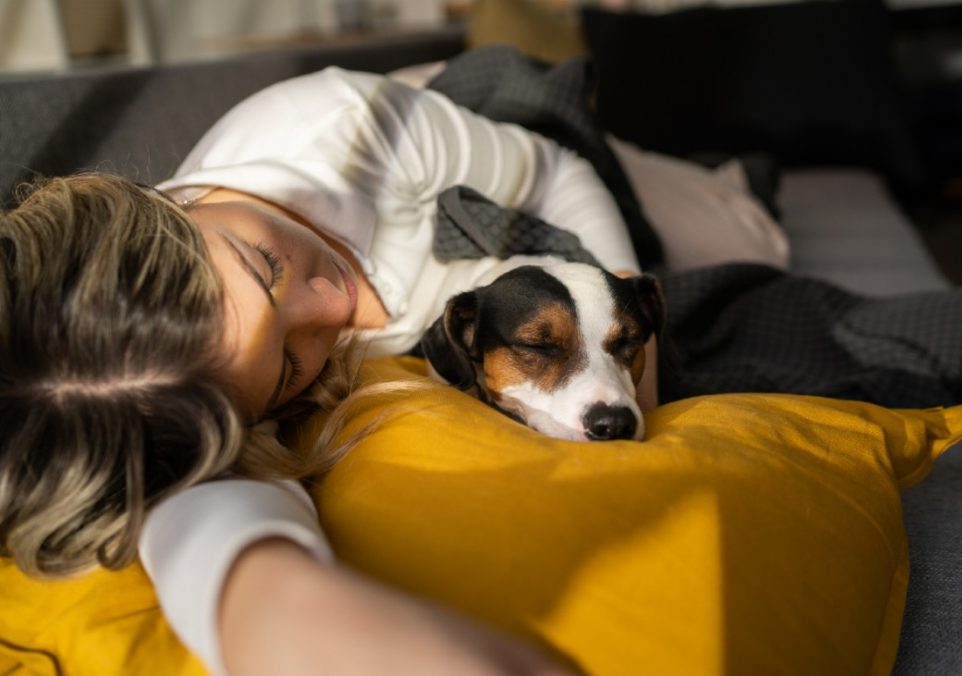Why Does My Dog Sleep on Me? 5 Tips for Transitioning Them to Their Own Bed

The presence of a dog brings warmth, joy, and a unique companionship to our lives. One behavior that many dog owners can relate to is their furry friend’s inclination to curl up and sleep on or beside them. While having a dog sleep on you can be heartwarming, it might lead to questions about the reasons behind this behavior and whether it’s beneficial in the long run. In this article, we’ll explore the various motives dogs might have for choosing to sleep on their human companions, and we’ll provide practical tips for gently transitioning them to their own bed, ensuring a restful night’s sleep for both dog and owner.
Why Dogs Sleep on You
Dogs are social animals that thrive on close bonds with their human families. Sleeping on or near you provides physical warmth, a sense of security, and a connection to your presence. It’s a testament to the deep bond and attachment your dog feels towards you. Additionally, your rhythmic breathing and heartbeat may be soothing to your dog, mimicking the comfort they experienced as puppies nestled against their mother’s side.
Tip 1: Introducing a Comfortable Bed
To transition your dog to their own bed, introduce a comfortable and inviting sleeping space. Choose a bed that matches their size and sleeping preferences, whether they prefer a plush cushion or a more structured mattress. You may also want to look at anti-anxiety dog beds if they are skittish or nervous. Place their bed in a quiet, cozy corner of your home, away from drafty areas and high-traffic zones.
Tip 2: Positive Reinforcement
Encourage your dog to use their bed by associating it with positive experiences. Place treats or toys on the bed and use verbal praise when they explore or lie down on it. Gradually increase the time they spend on their bed while providing positive reinforcement, creating a positive connection between the bed and rewards.
Tip 3: Familiar Scents
Dogs have a keen sense of smell, and familiar scents can provide comfort. Place a shirt or blanket with your scent on their bed to make it feel more inviting and reassuring. This can help ease the transition and make the new sleeping area feel like a familiar and safe space.
Tip 4: Consistent Routine
Dogs thrive on routine and predictability. Establish a consistent bedtime routine that includes leading them to their bed, offering a treat, and providing a calm and peaceful atmosphere. Consistency helps signal to your dog that it’s time to wind down and sleep in their designated area.
Tip 5: Gradual Transition
Transitioning your dog to their own bed might take time, especially if they’re used to sleeping on or beside you. Start by encouraging them to sleep on their bed for short periods while you’re still awake and present. As they become more comfortable, gradually increase the duration and reassure them with occasional pets and soothing words.
Conclusion
The desire of dogs to sleep on their human companions is a testament to the deep emotional connection they share with us. While this behavior can be heartwarming, establishing healthy sleep boundaries is crucial for both your well-being and theirs. Gently transitioning your dog to their own bed is an opportunity to nurture their independence while maintaining the bond you cherish. By creating a comfortable, inviting sleeping space and employing positive reinforcement, you’re paving the way for peaceful slumber and a harmonious balance between companionship and personal space. Remember, every dog is unique, and the transition may take time. Approach the process with patience, understanding, and the knowledge that your efforts will contribute to the overall happiness and well-being of your beloved canine companion.
Your Pet’s Best Interest, Always
At Pet Institute, we take pet care seriously. We're dedicated to transparency, impartiality, and the well-being of your pets in every article, review, and recommendation we provide. Our unwavering commitment to these principles ensures that you, our valued reader, always receive reliable and unbiased information. Let us be your trusted guide in the world of pet care and companionship.